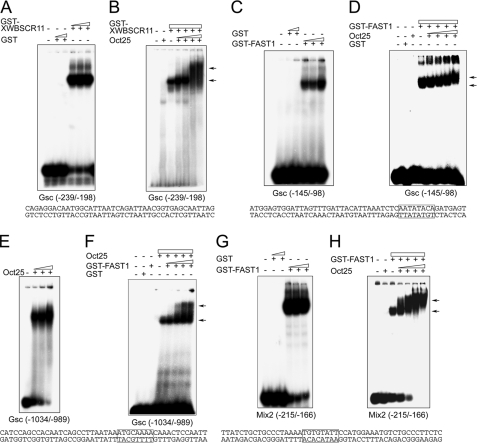FIGURE 3.
In vitro binding of Oct25 to Gsc and Mix2 promoters. A, increasing amounts of a GST-tagged XWBSCR11 fusion protein bind to an oligonucleotide containing the DE of the Gsc promoter (position -239 to -198), while GST itself does not show any binding. B, increasing amounts of Oct25 and GST-XWBSCR11 form a complex on the DE as displayed by a supershift. C, FAST1 specifically binds to an oligonucleotide containing the PE of the Gsc promoter (position -145 to -98) with a FAST1 binding motif. D, Oct25 forms a complex with FAST1 on the PE as revealed by supershifts. E, Oct25 binds to an oligonucleotide (position -1034 to -989) of the Gsc promoter containing an octamer-like motif. F, incubation of this region of the Gsc promoter with Oct25 and increasing amounts of GST-FAST1 fusion protein leads to a supershift. G, FAST1 interacts with the ARE of the Mix2 promoter (position -215 to -166) that contains a FAST1 binding motif. H, supershift generated with GST-FAST1 and increasing amounts of Oct25. The sequences corresponding to the regions of Gsc and Mix2 promoters used for EMSA and supershift assays are listed below each panel and protein binding motifs for FAST1 or Oct25 are boxed. The arrows denote supershifting.

